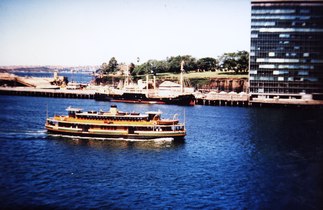 Kameruka early 1950s(?) as a steamer | |
| History | |
|---|---|
| Name | Kamiri, Kameruka |
| Operator | |
| Builder | Morrison & Sinclair |
| Cost | Kameruka: £13,178 [1] |
| Launched | 1912 (Kamiri) & 1913 (Kameruka) |
| Out of service | 1946 (Kamiri), 1984 (Kameruka) |
| Identification | Kamiri: O/N 131516 [2] |
| Fate | Kamiri broken up circa 1951, Kameruka laid up 1984, sank and broken up 1986 |
| General characteristics | |
| Tonnage | both 144 tons |
| Length | both 34.1m |
| Beam | 7.9 m |
| Capacity | both 594 passengers |
Kameruka and Kamiri were near identical ferries that served on Sydney Harbour. Kamiri was built in 1912 and Kameruka was launched on 8 February 1913. They were double-ended "K-class" steam ferries, a type that was prolific on Sydney Harbour in the early 20th century boom in cross-Sydney Harbour ferry transport before the 1932 opening of the Sydney Harbour Bridge. Kamiri was laid up in 1951 following the New South Wales government take-over of the Sydney Ferries Limited. Kameruka was converted to diesel in 1954 and was laid up in 1984.
Contents
Both ferries were part of a Sydney Ferries Limited tradition of naming their "K-class" ferries with Australian Aboriginal words beginning with "K". "Kamiri" is the name of an Aboriginal tribe and "Kameruka" is thought to mean 'wait til I come'.











